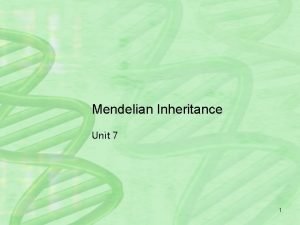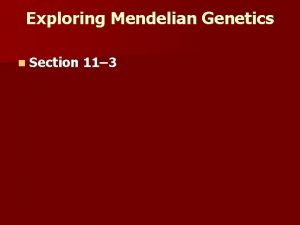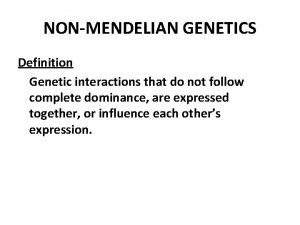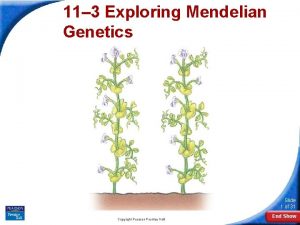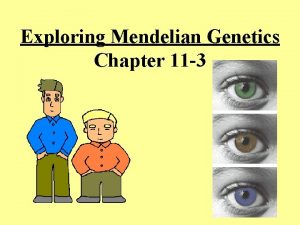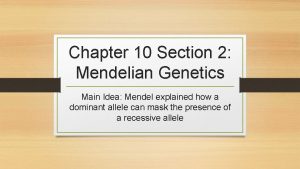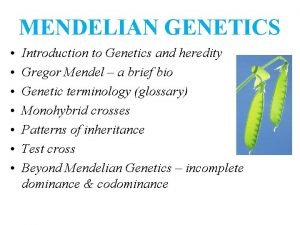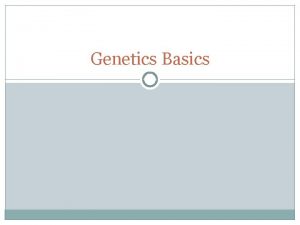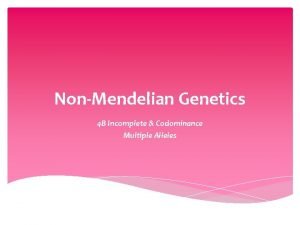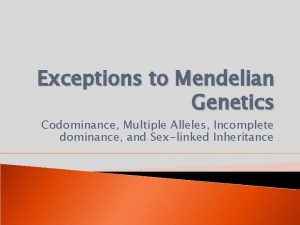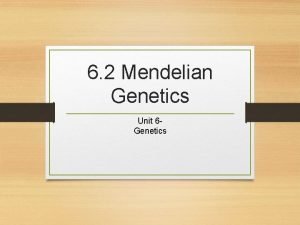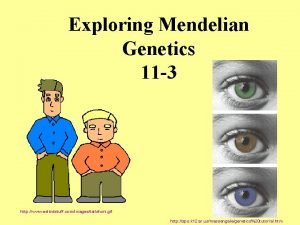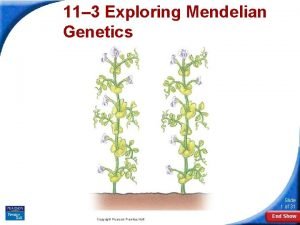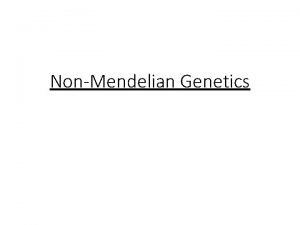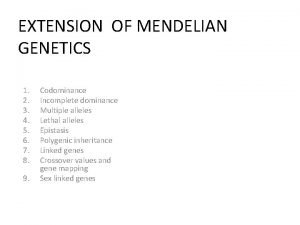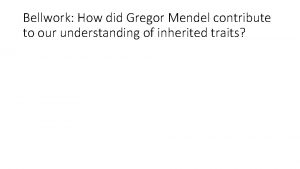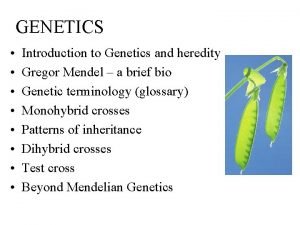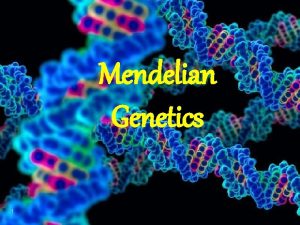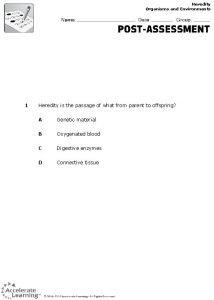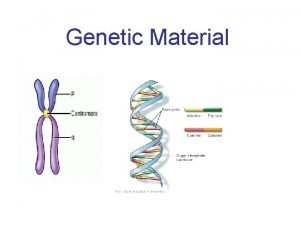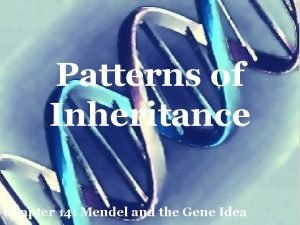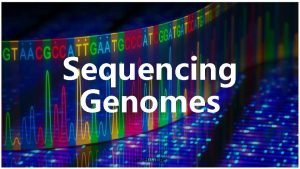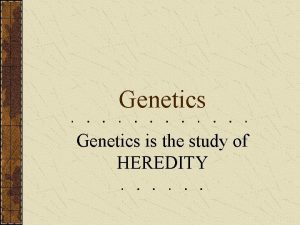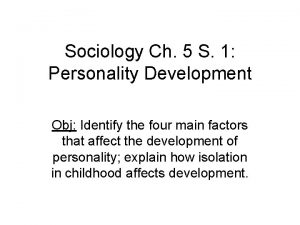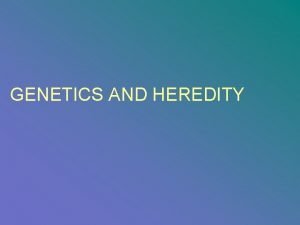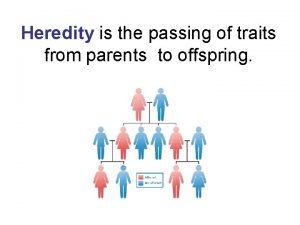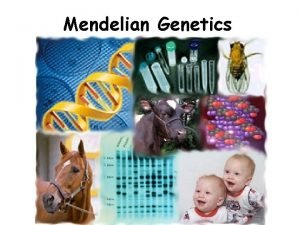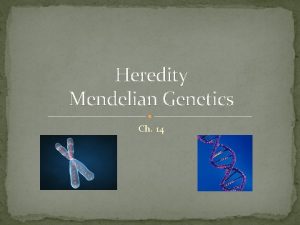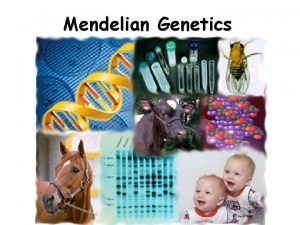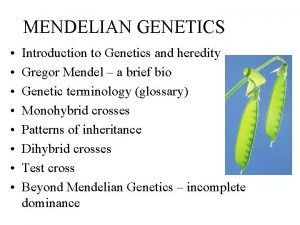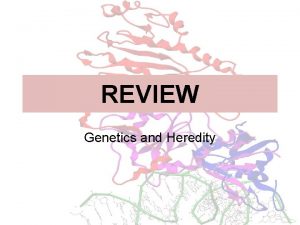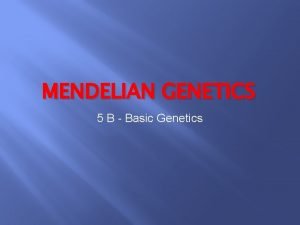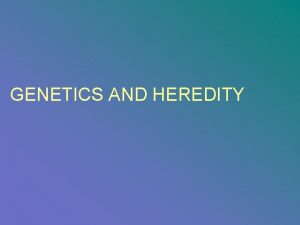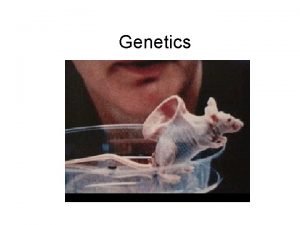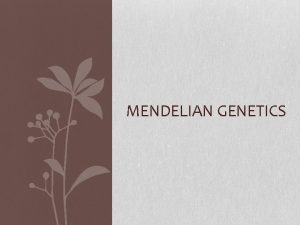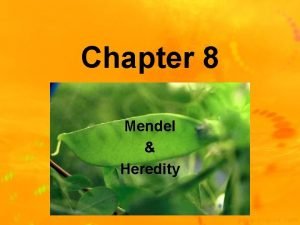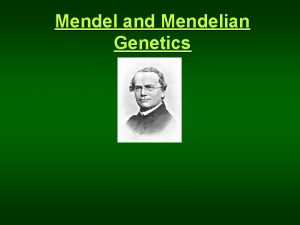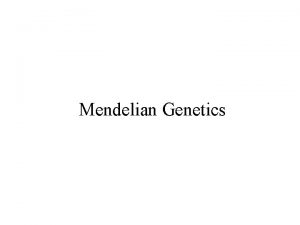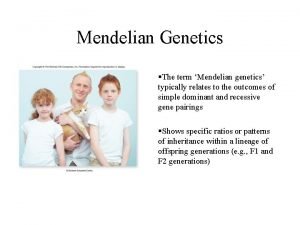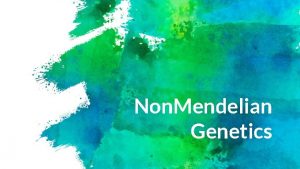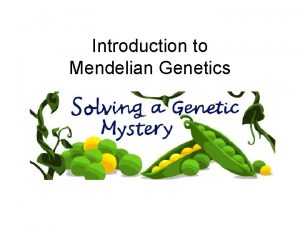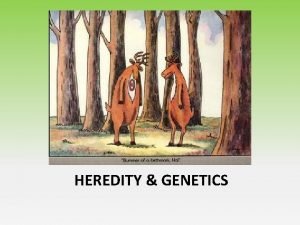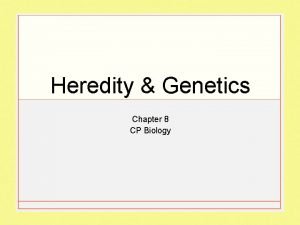Gregor Mendelian genetics explains the principles of heredity











































- Slides: 43

Gregor Mendelian genetics explains the principles of heredity

Why Pea Plants? ? ? • have easy to identify reproductive organs • easy to grow • have a short generation time • could be cross-pollinated (produces seeds that are the offspring of two different plants)

Genes vs. Alleles

Law of Segregation • each organism contains two factors for each trait (ex: widow’s peak and no widow’s peak) • factors segregate, or separate during Meiosis; each gamete contains one factor for each trait.


Punnett Squares!!!

Dihybrid Crosses • A cross that examines two pairs of contrasting traits • Example: Mendel looked at Color (yellow or green) and seed shape (round or wrinkled)

• Law of Independent Assortment stated that traits are inherited independently of each other

Dihybrid Crosses • Mendel crossed two plants from the F 1 generation • RRYY x rryy – F 1 generation • What are the possible genotypes?




Dihybrid Practice • In Guinea pigs, black hair (B) is dominant to white hair (b) and short hair (L) is dominant to long hair (l) • Cross a guinea pig that is heterozygous for both traits with guinea pig that is white and heterozygous for hair length.


Dihybrid Crosses • Tt. YY x Ttyy what are the possible genotypes? P 1 P 2

Dihybrid Practice • In mice, the ability to run normally is a dominant trait called running (R). The recessive trait causes mice to run in circles which is called waltzing mice (r). Hair color is also inherited in mice. Black hair (B) is dominant over brown hair (b). • Cross a heterozygous running, heterozygous black mouse with a homozygous running, homozygous black mouse

Dihybrid Practice • Cross a waltzing brown mouse with a running brown mouse • Remember Running (R), waltzing (r) Black fur (B), brown fur (b) • 2 answers are possible!!

Dihybrid Bellringer In Kentucky wildcats, long tails are dominant (T) to short tails (t) and stripes (S) are dominant to spots (s). Cross two wildcats that are heterozygous for both traits. What are the possible phenotypes?


Other Patterns Of Inheritance • Most alleles are not simply dominant or recessive • What determines dominance? Dominant genes code for polypeptides (enzymes) that work

Incomplete Dominance • when one allele is not completely dominant or recessive • The heterozygous phenotype is somewhere in between the two homozygous phenotypes • RED Flower x WHITE Flower ---> PINK Flower



Incomplete Dominance • Curly and Straight Hair • What would wavy hair crossed with wavy hair look like?

Codominance • More than one allele for the same gene are fully expressed • Two traits appear at the same time • black x white ---> red & white spotted


Polygenic Inheritance Traits which are the result of many gene combinations. Example of human traits: height, body weight, and skin color.

http: //www. youtube. com/watch? v=gouq. Tq 5 p 168

Eye Color Inheritance • OCA 2 is one of the genes and is dominant. • This is why brown eyes are said to be dominant over blue. It takes just one good OCA 2 gene to end up with brown eyes.


Multiple Alleles • Genes that are controlled by more than two alleles are said to have multiple alleles • An individual can’t have more than two alleles. However, more than two possible alleles can exist in a population.

Multiple Alleles § sometimes caused by mutations. § Some traits have up to 100 alleles. § Example: rabbit fur color fruit fly eye-color, and blood typing.

C = full color; dominant to all other alleles cch = chinchilla; partial defect in pigmentation; dominant to ch and c alleles ch = Himalayan; color in certain parts of the body; dominant to c allele c = albino; no color; recessive to all other alleles




Pleiotropy • a single gene influences many phenotypic traits • Individuals with Marfan syndrome tend to be tall and thin with long legs, arms, and fingers; are nearsighted; and the wall of their aorta is weak.

Marfan Syndrome

Gene Linkage • Two genes that occur on the same chromosome are said to be linked, and those that occur very close together are tightly linked • Example: a fly with reddishorange eyes most always have miniature wings

Environmental factors Internal · Age · Gender (hormone differences).

External factors can all influence gene expression. · Temperature (rabbit fur color, bacteria) · Nutrition · Light · Chemicals, Infectious diseases

Environment and Phenotype • Himalayan Rabbits - Enzyme coding for black fur is active only at low temperatures. – Black fur only occurs on extremities.

Environment and Phenotype: Himalayan Rabbits
 Mendelian theory of inheritance
Mendelian theory of inheritance Chapter 11 biology test
Chapter 11 biology test Gregor mendels principles of genetics apply to
Gregor mendels principles of genetics apply to Difference between mendelian and non mendelian inheritance
Difference between mendelian and non mendelian inheritance Intermediate inheritance
Intermediate inheritance Chapter 17 lesson 2 heredity and genetics
Chapter 17 lesson 2 heredity and genetics Section 11-3 exploring mendelian genetics
Section 11-3 exploring mendelian genetics Heredity concept map
Heredity concept map What is incomplete dominance simple definition
What is incomplete dominance simple definition 11.3 exploring mendelian genetics
11.3 exploring mendelian genetics Section 11-3 exploring mendelian genetics answer key
Section 11-3 exploring mendelian genetics answer key The scientific study of heredity *
The scientific study of heredity * Section 11-3 exploring mendelian genetics answer key
Section 11-3 exploring mendelian genetics answer key Chapter 10 section 2 mendelian genetics
Chapter 10 section 2 mendelian genetics Chapter 7 extending mendelian genetics vocabulary practice
Chapter 7 extending mendelian genetics vocabulary practice Codominant genes
Codominant genes Carrier female genotype
Carrier female genotype Non mendelian genetics codominance
Non mendelian genetics codominance Horse xnxn
Horse xnxn Mendelian genetics punnett square
Mendelian genetics punnett square 11-3 exploring mendelian genetics
11-3 exploring mendelian genetics Pedigree miscarriage symbol
Pedigree miscarriage symbol Karyotype
Karyotype Extending mendelian genetics
Extending mendelian genetics Chapter 7 extending mendelian genetics answer key
Chapter 7 extending mendelian genetics answer key Extending mendelian genetics
Extending mendelian genetics 11.3 exploring mendelian genetics
11.3 exploring mendelian genetics Is baldness a sex linked trait
Is baldness a sex linked trait Purebred vs hybrid
Purebred vs hybrid Pprr x pprr punnett square
Pprr x pprr punnett square Pp
Pp How did gregor mendel contribute to genetics
How did gregor mendel contribute to genetics Homozygous
Homozygous Chromosomes
Chromosomes Heredity terminology
Heredity terminology Heredity is best described as the -
Heredity is best described as the - Heredity
Heredity Cpalms heredity
Cpalms heredity Chapter 14 patterns of heredity
Chapter 14 patterns of heredity Sanger sequencing
Sanger sequencing ____________ is the study of heredity.
____________ is the study of heredity. An unchanging, biologically inherited behavior pattern.
An unchanging, biologically inherited behavior pattern. What is a pheontype
What is a pheontype Flower structure
Flower structure



